#ancient plant fossil
Explore tagged Tumblr posts
Text
Plants Surviving the Worst Mass Extinction
ESP Version ITA Version

When we think of mass extinctions, we often imagine the meteorite impact that killed the dinosaurs at the end of the Cretaceous, 65 million years ago. However, the greatest extinction event occurred between the Permian and Triassic periods, around 250 million years ago, eliminating over 96% of marine species and about 70% of terrestrial vertebrates. But how did plants fare?
According to a study conducted by University College Cork, the University of Connecticut, and the Natural History Museum of Vienna, plants did not experience a mass extinction comparable to that of animals. Nevertheless, their communities were severely impacted or even completely destroyed due to extreme climatic conditions: intense heat, drought, depletion of the ozone layer, widespread wildfires, and contamination by toxic heavy metals.
The study analyzed fossils from the Sydney Basin in eastern Australia, which at the time was located near the South Pole. Researchers gathered sedimentological data (physical, chemical, and depositional characteristics of sediments), biostratigraphic data (fossil distribution within rock layers), and stable carbon isotope ratios from organic matter, reconstructing environmental conditions of that era.
Fossils revealed that the first plants to recolonize devastated landscapes were conifers. Unfortunately, these conifers did not survive a subsequent period of extreme heat known as the Late Smithian Thermal Maximum, which lasted around 700,000 years. In this hostile environment, stress-tolerant, cosmopolitan lycophytes, similar to modern clubmosses, became dominant. Later, during a cooling event (Smithian-Spathian event), large and unusual seed ferns (such as "umkomasialea") emerged, gradually forming more stable and lush forests. These plants laid the foundation for the Mesozoic dinosaur era and the immense fern-dominated forests that persist in our collective imagination.
This research underscores the importance of protecting modern forests because, as the authors emphasize, "forests eventually recover, but the extinction of individual species is forever." Complete ecosystem recovery takes millions of years, and preserving today's plants ensures stability for future food webs and climate systems.
Pic by Fabien Monteil from Pixabay
Source
#Drops of Science#latest news#science#natural sciences#plants#conifers#fern#survival#extinction#fossils#research#Australia#geology#paleobotany#paleontology#mass extinction#Permian-Triassic#climate change#ancient forests#biodiversity#Earth's history
3 notes
·
View notes
Text

"Pennsylvanian book about Fossil Plants" is a comprehensive picture guide detailing fossil plants and marine organisms found alongside coal measures in Southwestern Virginia. Sorted by groups and coal seam horizon, it includes brief descriptions of each plant type. With 57 plates and over 280 illustrations, most in color, it caters to both amateur rock hounds and advanced collectors alike. For those eager to explore further, visit the book's website: https://www.tfmcloughlin.com/book/ for more information.
#Thomas F. McLoughlin#A Guide to Penssylvanian Age#Plant Fossils#Carboniferous#Southwest Virginia#ReadersMagnet#fossils#ancient plants#paleontology#paleobotany#fossil plants#nature
4 notes
·
View notes
Note
little fish game? looks at you?
It’s about being young and trans and having a conversation with a massive, ancient sturgeon as you walk the shore of the lake and discussing how the world changes and how people do to and this water tiling is killing me killing me killing me
#the Sturgeon’s name is Mags#after Magnolia plants#a sort of solidarity between ancient things#and you talk with them at the edge of the lake#and tell them about the world as is and your small town just over the hills and they tell you the names of the fossils that line the shore#and they give you advice and their older-than-dirt wisdom and hopefully something to hold close to your heart#and while it’s not actually a visual novel most of the game *is* that conversation as you walk the lake shore#asks#rome.rambles#2024
1 note
·
View note
Text






Amber
Amber is fossilized tree resin. Examples of it have been appreciated for its color and natural beauty since the Neolithic times, and worked as a gemstone since antiquity. Amber is used in jewelry and as a healing agent in folk medicine.
There are five classes of amber, defined on the basis of their chemical constituents.
The resins produced by plants acted as protection against the action of bacteria and against the attack of insects that pierced the bark until reaching the heart of the trees. The resin that came out of the wood ended up losing the air and water inside it. Over time, the organic substances that make up amber ended up polymerizing, thus forming a hardened resin that was resistant to time and water.
Since prehistoric times, the regions bathed by the Baltic Sea, such as Lithuania, Latvia and Estonia, have been the main source of amber. It is believed that the material has been used since the Stone Age. Objects of Baltic origin have also been found in Egyptian tombs dating back to 3200 BC. Another important clue were objects found in Scandinavia that were used by Vikings from the years 800 to 1000 AD.
Because amber can encase and protect even invertebrates like mollusks, it is ideal for preserving the smaller, more skeletal inhabitants of forest ecosystems. Over the course of nearly two centuries, paleontologists studying amber have found insects, arachnids, crabs, plants, fungi, nematodes, plants, microorganisms, and even a piece of a larger vertebrate animal.
But as you might imagine, the fossils that end up in amber are those of creatures that would be most likely to be buried in the resin of an ancient tree.
source: x, x
389 notes
·
View notes
Text
I was struck by how the entity’s growths formed in a spiral pattern, almost like a double helix you’d find in a strand of DNA. Oil is made from the fossilized remains of ancient plants and animals. It’s a sort of geological memory, just like how DNA is an evolutionary memory that allows the body to build and rebuild itself. And the primary thing that it affects when it touches people is their memories, whether random flashes of nostalgic images or deeply personally significant memories.
Going off of the DNA analogy…I don’t think the entity held any malice towards the crew. I don’t think it could hold malice to begin with, or goodwill, or any other more complex emotion. DNA is a chain of chemicals, and we have no conscious control over its transcription. The only thing it “wants,” as far as a chain of chemicals wants something, is to stay alive and to replicate itself. Its connection to oil also makes it feel like whatever dead, fossilized organic matter was trapped beneath the surface of the earth very mindlessly trying to return to life. The assimilated crewmates looked like cancerous lumps, growing out of control and endlessly dividing, not out of ill will, but because the cellular mechanism for growth had broken and was replicating out of control, only writ large, across the body of a whole person. The growths, like DNA writ large, a strand of chemicals trying to reassemble itself from whatever chemical matter from the rig and the crew it could use.
There’s a strange “humanity” to the entity, too, though in a very primal, instinctual sort of way. It wanted to be one with the rig and everyone on it, and it kept dredging up memories where Caz and the others felt especially close to their loved ones, even if they weren’t always happy ones. Caz, too, wanted to be one with his family again, but had that dream dashed by a selfish, individualist action. He wanted to keep his fellow crewmates together, and was increasingly devastated as assimilation or death cut them off from each other. The ending was beautiful, and felt like a barely comprehensible sort of kindness despite everything that had led up to it. For a moment, it felt like Caz reached an understanding with the force that had consumed him and that he in turn had destroyed, at least enough to forgive it and let go. In exchange, he got to relive the last time he and his wife were truly together, the morning he left for the rig. And then, over the empty ocean, we hear Suze’s tearful plea to Caz to come home, to reconnect with her, to be part of their family again. The letter felt like a summation of what Suze, Caz, and the entity itself wanted—to return home, to connect with others, to feel “whole” again.
969 notes
·
View notes
Text

A 2,000-Year-Old Pompeii Garden Springs Back to Life
The Pompeii Archaeological Park has recreated an ancient perfume garden—right down to its antique roses.
A garden once flourished in Pompeii. There, alongside a typical row house, olive trees, roses, and vines blossomed, nourished by hand-carved irrigation channels. The entrance to the site bore the Latin inscription “Cras Credo,” translated to “Credit will be offered tomorrow,” a touch of Pompeiian humor. The Vesuvius eruption in 79 C.E. wiped out the grounds—but preserved hints of its purpose.
Now, a new garden is taking root the same spot. The Pompeii Archaeological Park has just unveiled the restored Garden of Hercules (so named for a statue of the mythical hero uncovered at the site), freshly planted with 1,200 violets, 1,000 ruscus plants, and 800 antique roses, as well as vines and cherry and cotton apple trees. The botanical display is intended to mirror how the garden appeared 2,000 years ago, based on the findings of botanist Wilhelmina Jashemski, who identified pollen, spores, and plant fossils in the area in the 1950s.

“In Pompeii, the natural and archaeological landscape are one,” Gabriel Zuchtriegel, the park’s director, said in a statement. “The green of Pompeii, which was once perceived as a management and maintenance problem, an element almost separate from archaeological structures, is now recognized as an essential component of archaeological areas, as well as of the largest agricultural project of the Park.”
Located on Regio VIII, Insula 2 of the archaeological park, the house joining the garden was uncovered in 1953 before the rest of its grounds was excavated in 1971–72, with further studies carried out in the ’80s. Researchers found that the house was rebuilt following a 62 C.E. earthquake, with its owner buying surrounding land to plant the garden.

In the garden, archaeologists discovered holes in the earth that once held the roots of olive trees, impressions left in the soil by vine trellises, and biological traces of roses. Numerous perfume bottles found on the site indicate the garden was once involved in the commercial production of perfume. Flowers would be pressed with olive oil or grape juice, researchers found, before the concoction was bottled and sold.
Also significant was the discovery of an ancient irrigation system, which allowed gardeners to water the plants through a hole in the wall, without having to enter the site. The water would then flow through channels that wound their way around flower beds, or pool in reservoirs created by earthenware pots, or dolia, situated around the grounds.

“If a gardener needed to give extra water to a plant, they could take it from a dolia,” historian Maurizio Bartolini told the London Times.
Bartolini, who worked on the replanted garden, believes that the garden’s owner might have been experimenting with scents at the site, as opposed to running a full-scale operation. The garden, he noted, measures a mere 98 by 98 feet, while creating 5cc of perfume takes some 2,000 roses.

The irrigation system has been recreated for the Garden of Hercules, its troughs meandering across the new beds. A terracotta statue of the Greek legend has also been reproduced, installed in a small nook next to an outdoor dining space.
“This was a productive place,” Zuchtriegel told the Times of the space, “but also really beautiful.”
The recreated garden is part of Pompeii Archaeological Park’s efforts to shed light on daily life in the ancient Roman city before its destruction. Also currently on view at the site is “Being a Woman in Ancient Pompeii,” an exhibition that delves into the lives, roles, and activities of Pompeiian women.
By Min Chen.

#Pompeii#A 2000-Year-Old Pompeii Garden Springs Back to Life#The Pompeii Archaeological Park#Garden of Hercules#mount vesuvius#ancient artifacts#archaeology#history#history news#ancient history#ancient culture#ancient civilizations#roman history#roman empire#roman art#ancient art
142 notes
·
View notes
Text
Round 3 - Reptilia - Galliformes
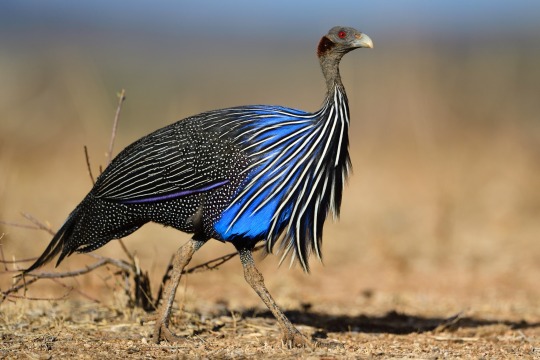
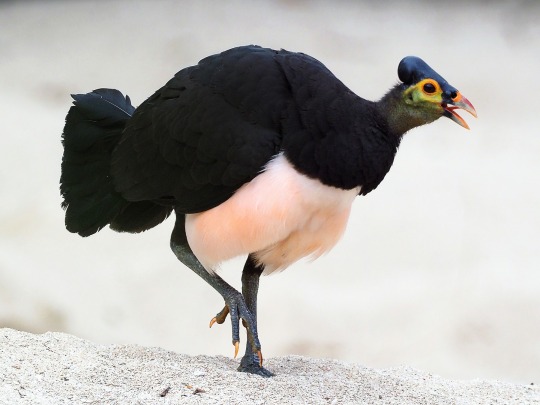


(Sources - 1, 2, 3, 4)
Our next order of birds are the ancient Galliformes, known collectively as “landfowl”. The order contains five families: Megapodiidae (megapodes), Cracidae (“curassows”, “guans”, and “chachalacas”), Odontophoridae (“New World quails”), Numididae (“guineafowl”), and Phasianidae (“pheasants”, “grouse”, “partridges”, “junglefowl”, “turkeys”, “Old World quail”, and “peafowl”).
Many gallinaceous species have rounded bodies and blunt wings. They are typically skilled runners and escape predators by running rather than flying, only using their wings to fly up to trees to roost or escape a predator when cornered. Galliforms are anisodactyl, with three toes that point forward and one that points backward, and some of the adult males also grow spurs that point backwards, which they use for fighting. They are usually omnivorous, feeding on fruits, seeds, leaves, shoots, flowers, tubers, roots, insects, snails, worms, lizards, snakes, small rodents, and eggs, depending on species. Galliforms are mainly nonmigratory. They can be found worldwide in a variety of habitats, including forests, deserts, and grasslands.
Galliforms have diverse mating strategies: some are monogamous, while others are polygamous or polygynandrous. Males of many galliform species are more colorful than the females, with often elaborate courtship behaviors that include strutting, fluffing of tail or head feathers, and vocal sounds. They breed seasonally in accordance with the climate and lay 3 to 16 eggs per year in nests built on the ground or in trees. Females usually brood the eggs, except for the megapodes.
Fossils of galliform-like birds originate in the Late Cretaceous. These ancestors of the galliformes were a niche group of dinosaurs that were toothless and ground-dwelling. When the asteroid impact killed off all non-avian dinosaurs, as well as the dominant birds, Enantiornithes, the ancestors of galliformes were small and lived in the ground which protected them from the blast and ensuing destruction, becoming the new dominant birds along with waterfowl. Modern galliformes originated in the Eocene, around 55 million years ago.
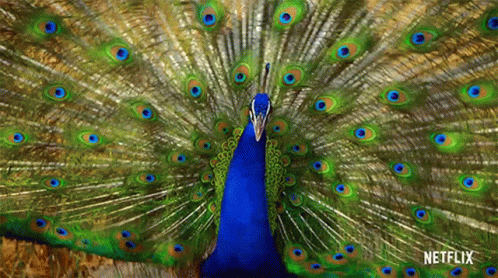
Propaganda under the cut:
The megapodes are unique among birds for their nesting behavior. Instead of sitting on their eggs, they build large mounds of decaying plant matter over them. The male will attend the mound, adding or removing litter to regulate the internal heat while the eggs develop. The Maleo (Macrocephalon maleo) (image 2) is most known for burying its eggs in a hole in the sand, allowing the eggs to be incubated by geothermal or solar energy heating up the sand. They leave the eggs once they are laid, and never return. Megapode chicks are the most precocial of all birds, digging their way out of the nest or ground with their powerful claws. They hatch fully feathered and active, already able to fly and live independently from their parents.
The Australian Brushturkey (Alectura lathami) is the largest living megapode. It is sometimes considered a pest, as it may take mulch for its nest or rake up gardens searching for food. However, it is fully protected in Queensland and New South Wales, and harming one of the unique birds can result in a fine of up to 3000 penalty units ($483,900), or two years imprisonment.
The endangered Horned Guan (Oreophasis derbianus) looks like this:

(source)
The critically endangered Blue-billed Curassow (Crax alberti) once used to range all across Northern Colombia, but is now reduced to small, fragmented populations, with the only known viable population existing in the Serranía de las Quinchas area in the Magdalena Valley. Its population is estimated to be fewer than 1,500 mature individuals. They are threatened due to habit loss, occurring from widespread use of herbicides by the Colombian government. Forests have also been cleared for agriculture, livestock, oil extraction, and mining. Around 98% to 99% of Blue-billed Curassow habitat has been lost. The birds are also hunted, and studied populations are not estimated to survive another 100 years if hunting continued. Thankfully, some reserves have been created and captive breeding has been successful. Now time will tell if the Blue-billed Curassow can be saved.
The iconic California Quail (Callipepla californica) (image 4) was selected as the state bird of California in 1931. They are highly social birds, gathering in small flocks known as "coveys". One of their daily communal activities is dust bathing.
One of the most well-known quails in North America, recognized by their characteristic whistling call, is the Northern Bobwhite (Colinus virginianus). The Northern Bobwhite is considered near threatened, and their populations have declined by around 85% since 1966. One subspecies, the Masked Bobwhite (Colinus virginianus ridgwayi), is endangered, and have been extirpated from Arizona twice. The decline is mainly due to changes in how land is managed. Northern Bobwhites depend on early successional habitat, that requires fire or some other disturbance to be revitalized. These habitats have the forbs, legumes and insects that bobwhite need for food and the heavy or brushy cover for nesting, brooding and safety. To help reverse bobwhite declines, NRCS (Natural Resources Conservation Service) is working with private landowners to manage their land for high-quality habitat in grasslands and pine savannas.
The Helmeted Guineafowl (Numida meleagris) was domesticated in Western Africa, and there is evidence that Domestic Guineafowl were present in Greece by the 5th century BC. The birds are kept for meat and eggs, but today are mostly kept for pest control, as they are avid eaters of ticks, wasps, and other insects. They are also kept as guard animals with other livestock, as they give a loud, shrill warning call when predators are seen. Feral populations descended from domestic flocks are now widely distributed and occur in the West Indies, North America, Australia, and Europe.
Unusually for galliforms, the Crested Partridge (Rollulus rouloul) will feed its young bill-to-bill, rather than teach it to peck at the ground, and both parents engage in this feeding behavior.
The Tragopans are also known as “horned pheasants”, due to the male’s courtship display in which he will inflate large, vividly colored horns on his head and a lappet on his chest.
The Himalayan Monal (Lophophorus impejanus) is the national bird of Nepal, and the males are one of the most colorful birds in the world, covered in patches of iridescent blue, purple, green, and red.
The Willow Ptarmigan (Lagopus lagopus) is the state bird of Alaska and has gained recent internet notoriety for its “awebo” call. They are known for changing color from brown to white in the Winter, and have remained relatively unchanged since the Pleistocene.
The largest galliform is the Wild Turkey (Meleagris gallopavo) which may weigh as much as 14 kg (30.5 lb) and may exceed 120 cm (47 in).
The Western Capercaillie (Tetrao urogallus) is a large grouse species, and is extremely sexually dimorphic, with males being nearly twice the size of females. Males are known for their combative behavior during the breeding season, even challenging and chasing off humans who enter their territory.
The critically endangered Edwards's Pheasant (Lophura edwardsi) may be extinct in the wild. The pheasants declined due to deforestation and hunting, but a major blow to their population was the use of defoliant herbicides used during the Vietnam War. The herbicides were sprayed by the United States to deprive the Vietnam soldiers of food crops and/or hiding cover. They also deprived the pheasants of food and shelter. There have been no confirmed sightings of a living individual in the wild since 2000. In 2018, a photograph of a dead female Edwards's Pheasant was taken near Phong Điền Nature Reserve, providing evidence that the pheasants may persist in the wild on the reserve. Thankfully, the pheasants breed readily in human care, and assurance populations are being prepared for release back into the wild.
The Domestic Chicken (Gallus gallus domesticus) was domesticated in Southeast Asia around 8,000 years ago, from the Red Junglefowl (Gallus gallus). They are kept for meat, eggs, as pets, and for cockfighting. Their domestication has led to them being the most widespread and successful birds in the world, with a total population of 26.5 Billion as of 2023, and an annual production of more than 50 Billion birds.
The smallest galliform is the King Quail (Synoicus chinensis), which is around 12.7cm (5in) long and weighs 28–40 g (1–1.4 oz).
123 notes
·
View notes
Text


My latest painting, inspired by ‘living fossil’ species! While not an exact scientific term, these are species which highly closely resemble ancient ancestors in the fossil record. I considered other iconic ancient species like the coelacanth and hoatzin, but settled on this composition. Even the plants are living fossils!
My studio is getting crowded with works!
#my art#acrylic painting#pelican#horseshoe crab#arowana#nautilus#also featuring a gingko tree and water lotus#nature#someone stole my dungeon meshi poster right off the wall of my studio and tbh I’m pissed. That thing had four nails attaching it to the wal#Art heist of the century
65 notes
·
View notes
Text

Voronya Cave, the closest point to the center of the Earth !
Voronya Cave, also known as Krubera Cave, is the deepest cave in the world.
The cave, Krubera-Voronya, is considered the “Everest of Caves”. The total length of the cave passages reaches 13,232 m, the depth is -2,197 m. It is located in Abkhazia (Georgia) near the Sea black.
The elevation difference between the cave entrance and its deepest explored point is 2,197 ± 20 meters (7,208 ± 66 feet). It became the deepest known cave in the world in 2001, when the expedition of the Ukrainian Speleological Association reached a depth of 1,710 m (5,610 feet), which surpassed the depth of the previously known deepest cave, Lamprechtsofen, in the Austrian Alps, by 80 meters (260 feet).
In 2004, for the first time in the history of speleology, the expedition of the Ukrainian Speleological Association reached a depth of over 2,000 meters (6,600 feet) and explored the cave up to -2,080 m (-6,824 feet).
The Ortobalagan Valley extends along the Berchil'sky anticliminal ridge, which descends gently northwestward. The entrances to the caves are lined along the anticlinial ridge, but the caves are controlled by longitudinal, transversal and oblique faults and include complex winding patterns in the plant view, remaining largely within and near the ridge area anti-clinical.
Caves are predominantly a combination of shallow wells and steep snake passages, although in some places they cut seemingly ancient fossil passages at different levels.
#art#stairwell#stairway#caves#nature#earth#underworld#voronya cave#voronya#krubera cave#georgia#earth wonders#speleology
323 notes
·
View notes
Photo

Stigmaria Fossil Stem Carboniferous Coal Measures Scotland UK | Musselburgh Plant Fossil with Certificate
This listing is for a beautifully preserved Stigmaria fossil stem, originating from the Carboniferous Period, specifically the Coal Measures of Musselburgh, near Edinburgh, Scotland, UK. This is a genuine piece of ancient plant life from approximately 310–300 million years ago, dating to the late Carboniferous (Pennsylvanian) sub-period.
The fossil shown in the photos is the exact specimen you will receive. It has been carefully selected for its distinct features and natural history significance, making it ideal for collectors, educators, and anyone interested in palaeobotany.
Geological & Palaeontological Details:
Fossil Type: Root/stem structure (rhizomorph) of an ancient lycopsid plant
Genus: Stigmaria (likely belonging to the root system of Lepidodendron or Sigillaria)
Order: Lepidodendrales
Geological Period: Carboniferous
Stage: Pennsylvanian (Westphalian)
Stratigraphy: Coal Measures (part of the Scottish Coal Measures Group)
Location: Musselburgh, Edinburgh, Scotland, UK
Depositional Environment: Low-lying equatorial swamp and floodplain environments where dense lycopod forests flourished. These environments formed the organic-rich layers that eventually transformed into coal seams.
Morphology & Features:
Stigmaria is characterised by a cylindrical, branching root structure with spirally arranged rootlet scars, forming the distinctive pitted pattern seen on the fossil’s surface
The preserved features show clear detail of the rootlet attachment points that supported anchorage in soft, waterlogged substrates
Typically preserved in grey shale or siltstone, reflecting anoxic burial conditions ideal for fossilisation
Provides key insights into the rooting systems of Carboniferous lycopod trees, the dominant flora of ancient coal-forming forests
Notability: Stigmaria fossils are among the most iconic plant fossils of the Carboniferous. Their distinct morphology and association with Lepidodendron and Sigillaria make them critical to understanding the ecology and evolution of the Earth’s earliest forested ecosystems. This specimen, from the historically significant coalfields near Musselburgh, represents a rare and regionally important find.
Additional Details:
All our fossils are 100% genuine specimens
Includes a Certificate of Authenticity
Photo shows the exact fossil for sale
Scale cube = 1cm – please refer to photos for precise sizing
Whether for education, research, or private display, this specimen offers a tangible connection to the lush primeval landscapes that once covered prehistoric Scotland. A perfect addition to any fossil or palaeobotanical collection.
#Stigmaria#plant fossil#Carboniferous fossil#Coal Measures#fossil stem#root fossil#Lepidodendron root#Musselburgh fossil#Edinburgh fossil#Scottish fossil#UK plant fossil#genuine fossil#fossil with certificate#fossil roots#Carboniferous flora#Stigmaria fossil stem#ancient plant fossil#fossilised roots#fossil collector specimen#Stigmaria rhizome
0 notes
Text
Happy Wasp Wednesday! New (ancient) species, genus, and possibly family dropped recently!
Sirenobethylus charybdis, placed in family Sirenobethylidae, and superfamily Chrysidoidea! This species is particularly notable for an adaptation discovered on its abdomen, at the end of the metasoma—The long since extinct species possessed a unique, paddle-shaped structure consisting of a series of movable flaps, often compared to a venus fly trap, as it is believed by these researchers that it was used to grasp and restrain their hosts (with other, less likely theories suggesting that it was instead intended to grasp onto their mating partners), with some hairs along the structure possibly even being "trigger hairs", another similarity to the aforementioned carnivorous plants!
Features of this structure suggest that this grasping ability was not intended to incapacitate the host, indicating this species was a koinobiont parasitoid, meaning that the host was set free and allowed to continue living, until presumably being consumed by the wasp's young.
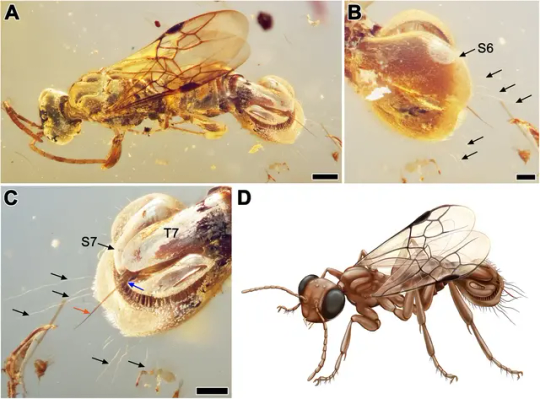
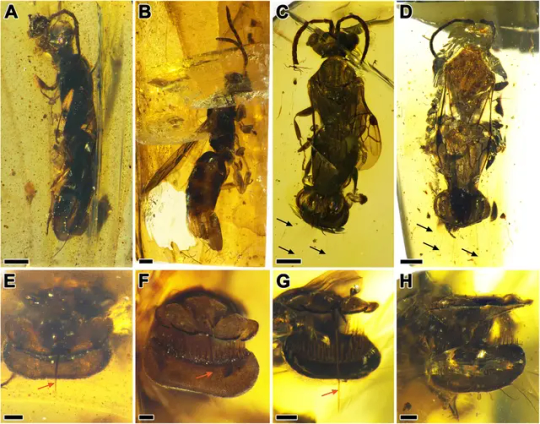
[Image Sources: BMC Biology, article authored by Qiong Wu, Lars Vilhelmsen, Xiaoqin Li, De Zhuo, Dong Ren & Taiping Gao | Image IDs: Figures 1 and 3 from the linked article. One shows 3 angles of a Sirenobethylus charybdis holotype female, displaying it's grasping apparatus up close, making the flaps apparent, followed by an illustration of the species. The other shows 4 different amber-encased females of the same species, with more close-ups further showing the structure on each of them, with the flaps in different relative positions and the hairs/setae more visible. /End IDs.]
They are not the first species we have discovered that can grasp onto their hosts, as some female wasps of the family Dryinidae use claws on their forelimbs to grab onto small hoppers (in the order Hemiptera)—However, they are reportedly the first insect we've ever discovered with a structure of this particular shape and apparent function!
54 notes
·
View notes
Text
Most animals and plants never fossilize. For those that do, it's usually only hard parts such as bones and shells that preserve. However, in some exceptional cases, soft tissues such as muscles and gills survive the fossilization process and can present a wealth of information about the biology and ecology of ancient organisms. In a paper recently published in Palaeontologia Electronica, Dr. Adiel Klompmaker, University of Alabama Museums' curator of paleontology, and colleagues reported on a remarkable crab with multiple mineralized soft tissues preserved. This crab lived 75 million years ago during the Cretaceous in the area of present-day South Dakota in an ancient sea known as the Western Interior Seaway.
Continue Reading.
403 notes
·
View notes
Text
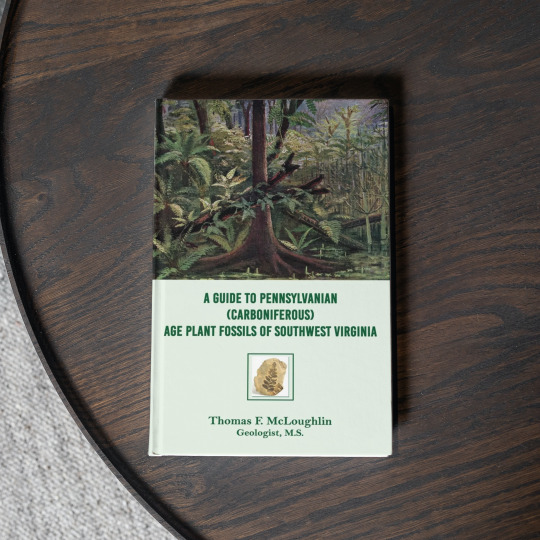
A Guide to Pennsylvanian (Carboniferous) Age Plant Fossils of Southwest Virginia by Thomas F. McLoughlin
Dive into the incredible fossil history of the Central Appalachians with "A Guide to Pennsylvanian (Carboniferous) Age Plant Fossils of Southwest Virginia" by Thomas F. McLoughlin, brought to life by over 300 vibrant images and clear explanations. This friendly guide brings fossils to life for everyone, from beginners to seasoned collectors.
Explore the ancient world beneath your feet. Grab a copy at www.tfmcloughlin.com.
#Thomas F. McLoughlin#A Guide to Penssylvanian Age#Plant Fossils#Carboniferous#Southwest Virginia#ReadersMagnet#fossils#ancient plants#paleontology#paleobotany#fossil plants#nature
0 notes
Text
Geology and the Economy/Trade in Your Fictional World: Explained
Hi, I'm Bird. I am a geology Ph.D. student and I love reading fiction and playing videogames, however something that can really pull me out of a fictional universe is a lack of understanding of basic geology, and how that would influence your fictional world. Today I will cover geology that can effect trade, some landscape features, and construction!
Things that are typically necessary/desired in a fictional world are building materials, gemstones/precious metals, and fossil fuels/ sources of energy. However, a lot of these things are not found together, and they typically have some features to make them more distinct in terms of landscape, so lets talk about it!
Gemstones/ Precious metals and landscape features
Typically, gemstones can be found in two different rock types. The first is intrusive igneous rocks (magma that slowly cooled underground to form course-grained rocks like granite) and high grade metamorphic rocks (rocks that got put under intense heat and pressure under the earth's surface). Some minerals are more likely to form in particular conditions than others, but for the most part these minerals can be found interchangeably within both of these places. *Note: this is a gross oversimplification but we are starting small
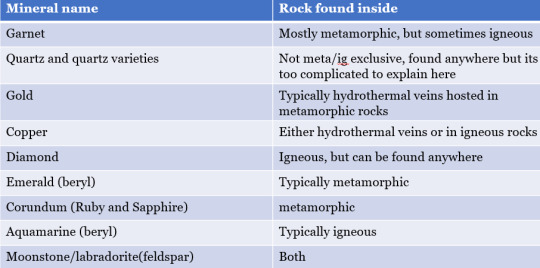
(Yes it is a shitty chart better pictures will come further in the post)
If you are writing these minerals based off and igneous deposit, good descriptions for the rocks would be speckled, with mineral grains of about the same size and varying in color. They should NOT be striated, and they will often form bald (unforested) cliffs that are typically rounded and not jagged.
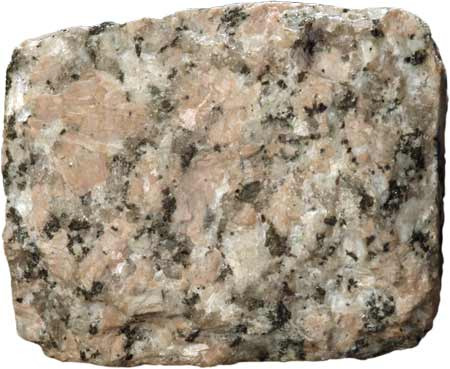
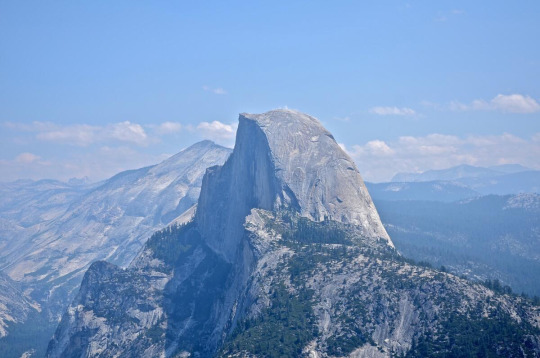
If you are writing with metamorphic rocks, you would expect these rocks to be layered, typically having light and dark layers with some minerals possibly being much larger than the others surrounding it. These textures can definitely (sometimes) be observed from a distance.
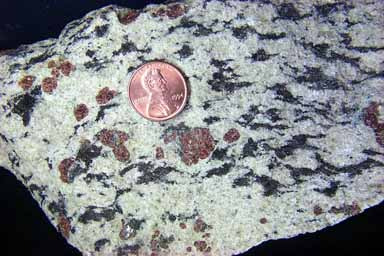
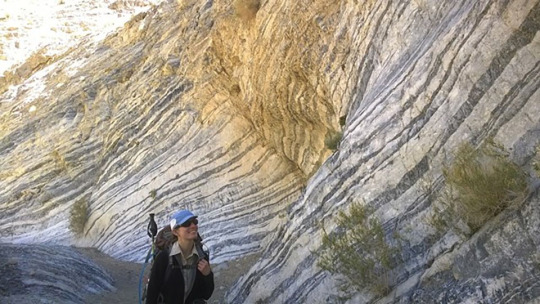
*Final notes about minerals* Quartz varieties are difficult, quartz can be found in volcanic, metamorphic, sedimentary, and intrusive igneous settings. If you are writing about agate specifically it is almost always volcanic in nature.
Diamonds are found in volcanic ash deposits called kimberlites, these deposits can occur in any rock type, so while they are igneous, they can be found anywhere. They have zero connection to the surrounding rocks.
2. Fossil Fuels
If a region is producing oil or coal, it is going to be from a sedimentary environment that is very rich in ancient plant material (like millions of years old). A unique feature of these locations would be finding lots of plant fossils, and rocks that can be found in association with these would be sandstone, shale, conglomerates/breccias, and limestones. Sedimentary rocks form in layers, so if exposed the layers will be very visible from a distance. You can also get unique features due to preferential weathering (fancy way of saying some rocks are harder than others, so when exposed to the same weather some rocks will break down faster than others). Also, natural oil seeps are a thing in places where natural oil is prevalent, but I couldn't find a good picture sorry.
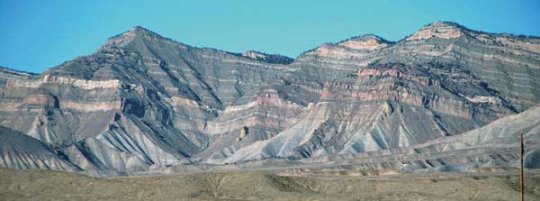
3. Building Resources
based on the rocks found in each region, the buildings will be made out of different materials, so lets breakdown what building materials would be used based off what rocks are present in the location.
Sedimentary rocks- lots of options here, so I will just info dump. If the region is drier, limestone is a good choice, historically may desert areas use limestone, it is soft and easy to carve, but it will dissolve slowly with rain. Sandstone is a durable rock that can be used, but it is very hard as it is made of quartz. Clay! shale breaks down in humid environments and will often make clay, this is a great, amazing building resource that could drive economy.
Metamorphic rocks- Marble.... if you want to make luxurious marble temples, metamorphic rocks are a must! Other comments, metamorphic rocks will often have layers of weaker minerals and stronger minerals, that means they will break along a defined surface. A lot of older houses in the Italian Alps (Aosta Valley) use these rocks for roofing. Slate roofing is also common in a lot of places, slate is formed from really low grade metamorphism, so this resource can be available in both sedimentary and metamorphic locations within reason.
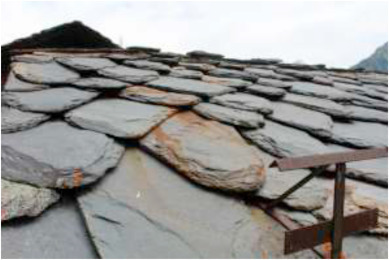
Igneous- Granite (light) and Gabbro (dark) is very hard and therefore it is used frequently in countertops today. This is also important because these rocks will take a high shine from polishing. Igneous rocks are also perfect for making cement! Volcanic ash mixed with quicklime and salt water is the recipe for roman concrete which is arguable much better than current day concrete but otherwise doesn't offer much more benefit.


Thank you if you made it this far, I want to make more guides in the future to hopefully cover more geology topics that can influence a story (possibly natural disasters and associated landscape features for subtle foreshadowinggggg)
This guide is very simplified! It is supposed to cover a lot of information for people who may not know a lot about geology, but are interesting in creating fictional universes! If you know a lot about geology already, please avert your eyes, or comment something additional!
#geology#rocks#science#creative writing#dnd#worldbuilding#writeblr#fictional world#dnd worldbuilding#writerscommunity#writing resources#writing tips#writing prompt#stem#worldbuilding stuff
574 notes
·
View notes
Text



Poaceae The grass family including Cortaderia selloana (Pampas grass) and Miscanthus sinensis (Zebra grass)
I don't really think of members of the grass family as flowering plants, but of course they are. The grass family is huge with 780 genera divided into over 12,000 known species, making Poaceae the fifth largest plant family in the world. The grass family doesn't have pretty flowers because it doesn't need to attract insects. All grasses are wind-pollinated.
The grass family is ancient. Seeds from Poaceae species related to modern rice and bamboo have been found in fossilized dinosaur dung from the late Cretaceous period but the grass family really got going about five million years ago. New mountain chains (like the Rockies) created much larger dry habitats, ideal for the vast grasslands to develop. Today, just three species (rice, corn and wheat) provide half of humanity's daily calories.
I've never grown ornamental grass but one one of my neighbors has thoughtfully planted these two common species in the front garden. I know all about that combination of grass species we call a lawn and I've struggled with mine for thirty-five years. Incidentally, I'm giving away my rechargeable lawn mower next week because I've sold my house. The mower works just fine but I won't need it to mow my balcony. I'm moving at the end of the month to a fourth-floor condo.
It has come to this.
#flowers#photographers on tumblr#grass#moving day#goodbye lawn#fleurs#flores#fiori#blumen#bloemen#Vancouver
88 notes
·
View notes
Text
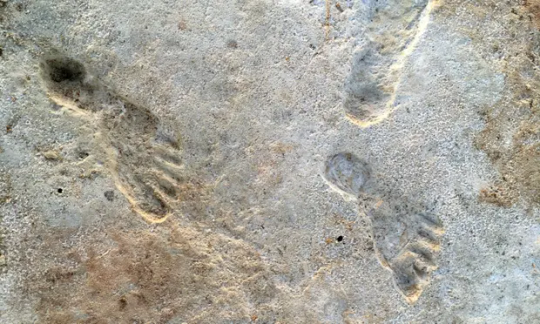
New Mexico Footprints are Oldest Sign of Humans in Americas
Fossil footprints date back to between 21,000 and 23,000 years ago, upending previous theory that humans reached continent later.
New research confirms that fossil human footprints in New Mexico are probably the oldest direct evidence of human presence in the Americas, a finding that upends what many archaeologists thought they knew.
The footprints were discovered at the edge of an ancient lakebed in White Sands national park and date back to between 21,000 and 23,000 years ago, according to research published on Thursday in the journal Science.

The estimated age of the footprints was first reported in Science in 2021, but some researchers raised concerns about the dates. Questions focused on whether seeds of aquatic plants used for the original dating may have absorbed ancient carbon from the lake – which could, in theory, throw off radiocarbon dating by thousands of years.
The new study presents two additional lines of evidence for the older date range. It uses two entirely different materials found at the site, ancient conifer pollen and quartz grains.
The reported age of the footprints challenges the once conventional wisdom that humans did not reach the Americas until a few thousand years before rising sea levels covered the Bering land bridge between Russia and Alaska, perhaps about 15,000 years ago.
“This is a subject that’s always been controversial because it’s so significant – it’s about how we understand the last chapter of the peopling of the world,” said Thomas Urban, an archaeological scientist at Cornell University, who was involved in the 2021 study but not the new one.

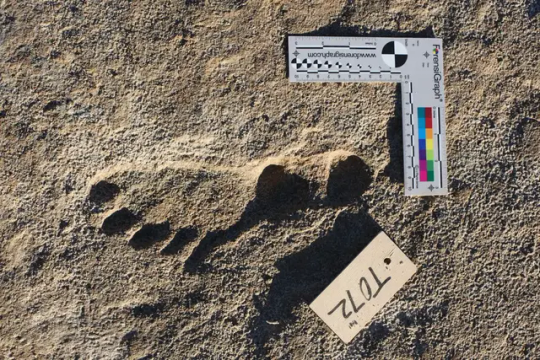
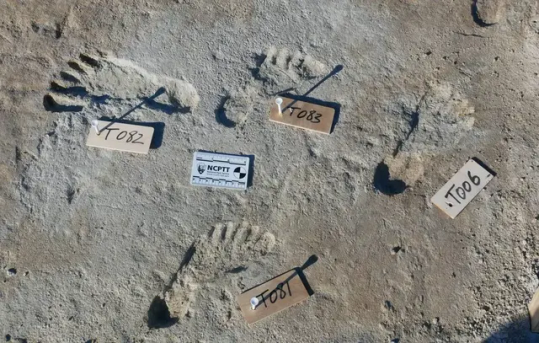
Thomas Stafford, an independent archaeological geologist in Albuquerque, New Mexico, who was not involved in the study, said he “was a bit skeptical before” but now is convinced.
The new study isolated about 75,000 grains of pure pollen from the same sedimentary layer that contained the footprints.
“Dating pollen is arduous and nail-biting,” said Kathleen Springer, a research geologist at the US Geological Survey and a co-author of the new paper.
Ancient footprints of any kind can provide archaeologists with a snapshot of a moment in time. While other archeological sites in the Americas point to similar date ranges – including pendants carved from giant ground sloth remains in Brazil – scientists still question whether such materials really indicate human presence.
“White Sands is unique because there’s no question these footprints were left by people, it’s not ambiguous,” said Jennifer Raff, an anthropological geneticist at the University of Kansas, who was not involved in the study.
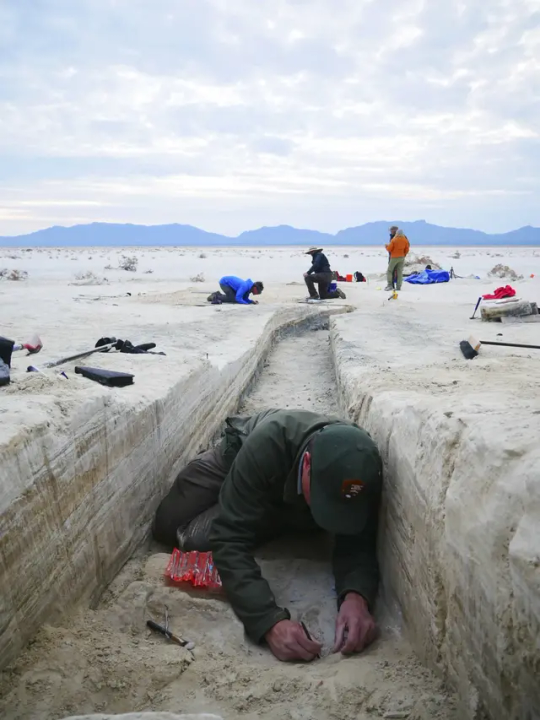
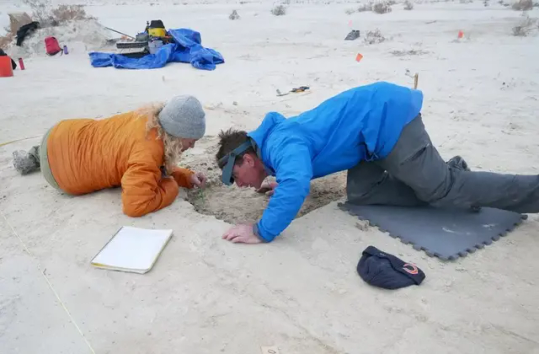
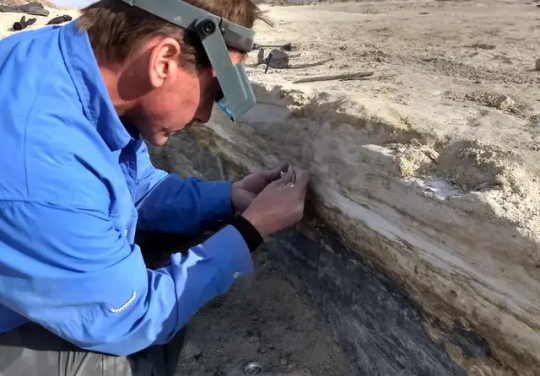
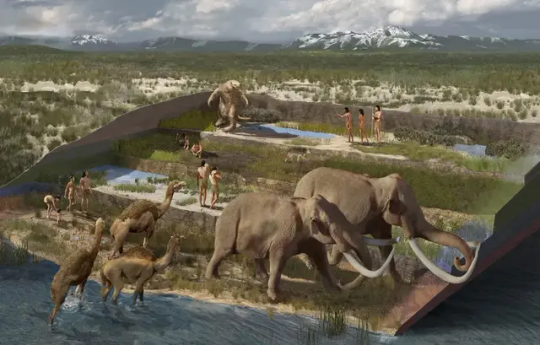
#New Mexico Footprints are Oldest Sign of Humans in Americas#fossil#fossil footprints#White Sands national park#ancient artifacts#geology#geologist#archeology#archeolgst#history#history news#ancient history#ancient culture#ancient civilizations#ancient man
707 notes
·
View notes